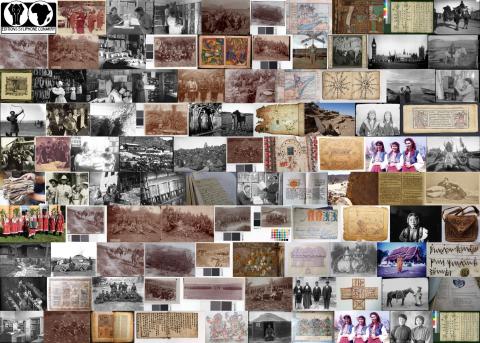Aims and objectives
This pilot project aims to document available non-copyrighted and endangered literature from private collections and public institutions in the district of Nadia. Shantipur, the old cultural hub in pre-colonial Bengal, will be in the centre and the project will survey collections of books, manuscripts, photographs and other images with historical importance. A list will be prepared and all published documents will be cross-checked with other holdings for rarity - only the unique items will be planned to be digitised in a future major digitisation project.
Nadia district has had a long history of urban settlements since the 11th century: Nabadwip was the capital of the Sena dynasty during the 11th and 12th century, and also the birthplace of Shri Chaitanyadeva, founder of the Vaishnav religion. Shantipur has a long medieval cultural history. Krishnanagar too, was a small Hindu kingdom under the Nababs of Murshidabad from the 17th century until the early regime of the East India Company. All three settlements were once places of traditional Indian learning and the history of several tols (local small school run by an individual) are well known in the region - primarily places for Sanskrit learning and teaching. Although almost all tols disappeared with the advent of European education from the mid-19th century, the history of those institutions are still available in a few private collections. The sources of history writing of the region have not been documented up until now.
The books, serials and images are important sources for studying the pre-modern period in Bengal and understanding South Asian historiography. All of these collections, either private or public, are endangered. The heat and humidity of South Asia are transforming these old printed books to paper pulp and without immediate attention they will disappear forever. White ants are destroying the books and make handling the material an almost impossible task for most of the collections.
The project team will index books and cross-check their availability in the OCLC public access catalogue, British Library Cataloguing data, rare book collection of the National Library of Calcutta, and in the CSSSC archive database. If a title cannot be located on any of the databases then the document will be marked for future digitisation.
The expectation from this project is to detail printed books on Vaishnavism, biographies and family histories of Vaishnavaite leaders, the colonial history of the Btahmo movement in the region, printed literature on caste and identity, Bengali literature in general, printed literature and manuscripts on local handloom and the migration pattern of local weavers, which is a tradition and history of ancient times.
The outcome from the project therefore will be a list of printed materials, checked for uniqueness against available databases; a list of photographs and paintings relating to the history of the locality and Bengal; and a list of manuscripts not already digitised by the National Manuscript Mission of India. This will form the basis of a future major digitisation project.
Outcomes
During this pilot phase the research team surveyed existing public libraries and private collections. The team started with the collection of Santipur Sahitya Parishad and listed 1,635 books, of which 1,360 were found to be unique. However, during a dissemination workshop a good response was received from the Government of West Bengal, and the Director of Library Services committed to digitise the collection. The collection started to be digitised in January 2014 and is expected to be available online through West Bengal Public Library Network. In view of that, further EAP work will not be carried out at the library to avoid duplication. For all other places the digitisation should start as soon as possible. As all libraries and institutions are desperately lacking funding, the collections are mainly stored in collapsing buildings with two exceptions.
One is the excellent collection of paintings, prints and photographs of Lalit Mohan Sen, stored in good conditions in the 19th century house of the Sen family; a total number of 533 paintings, prints and photographs are available in the collection.
Another is a unique collection of resolution books and other records, revealed in a search of the record room of Santipur Municipality. The municipality is the second oldest civic body for local self-governance with an all-native committee established in 1853. Even at that time inclusion of natives in a civic body was a debate in Calcutta Municipal Corporation. The Municipal record room has manuscript resolution books from the year 1853, important documents to understand the process of urbanisation and function of civic body under colonial and post-colonial rule. All the records in the record room are more or less well kept.
Santipur Brahmo Samaj (1886) has a small book collection from where 400 books were listed, of which 288 were unique.
The small village of Phulia is well known for the birthplace of Krittibas, author of the Bengali Bhakti version of Ramayana. The Government of West Bengal built a memorial in the birthplace of the poet here in 1960. Mentors of the library, a part of the memorial, put their best effort to collect all available versions of the epic Ramayana to keep here. 117 books were listed on the epic literature, and 87 of them were found to be unique.
The most resourceful place of the district is Santipur Bangiya Purana Parishad, custodian of over 2,000 manuscripts and hundreds of books related to teaching language, culture, and religion. This pilot project only assessed the collection but not listed, as it required special expertise in reading the manuscripts.




